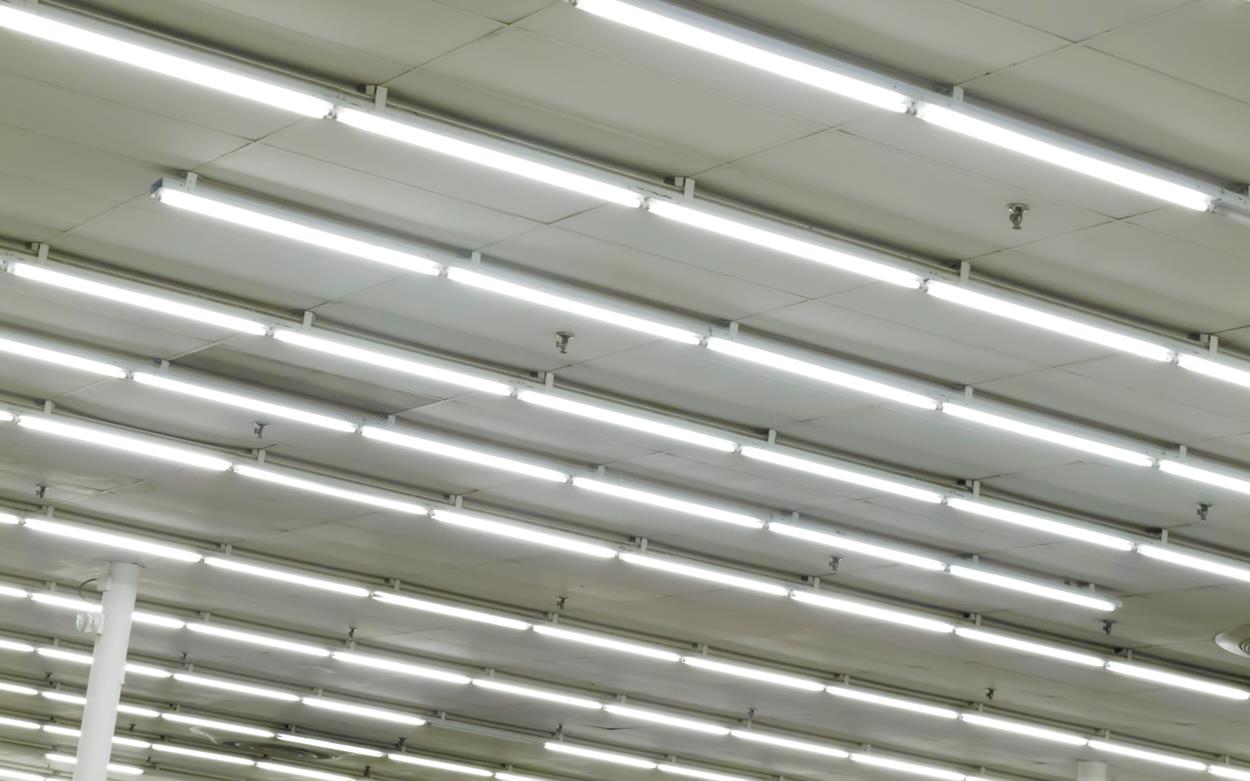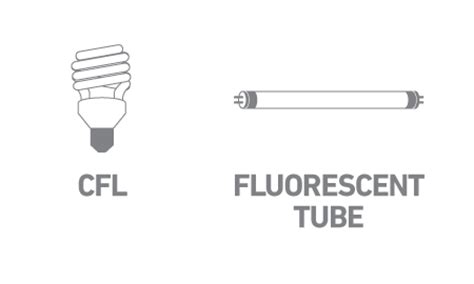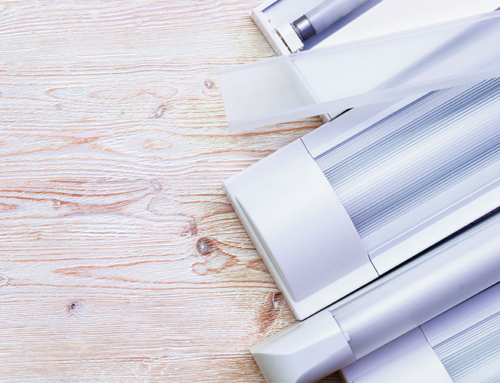
Fluorescent lamps are a specific type of gas-charged luminaire that produce light through a chemical reaction that involves gases and mercury vapor interacting to produce UV light inside of a glass tube. The UV light illuminates a phosphor coating on the inside of the glass tube which emits a white “fluorescent” light. Fluorescent lights have a variety of great advantages over old lighting technology, like incandescents. They’re much more efficient, so they use less energy. They also have a longer lifespan—about 13x longer—so they don’t need to be replaced as often.
Due to the widespread availability of fluorescent lighting technology, you can find them almost anywhere—in schools, hospitals, grocery stores, office buildings, shopping malls and our homes. While LED (light-emitting diode) technology is set to replace fluorescent light as the “king of green lighting choices” in the very near future, many facility managers continue to utilize fluorescents in their buildings. For now, fluorescent lighting products may be cheaper than their more-efficient LED counterparts, but there are drawbacks to fluorescent lighting that need to be considered.
Compact Fluorescent Lamps (CFLs) vs Fluorescent Tubes

The primary difference between the two is size and application. Most compact fluorescent lamps (CFLs) come in special shapes that allow them to fit into standard household light sockets. Another difference is that linear fluorescent tubes require an independent ballast that is separate from the bulb whereas most compact fluorescent light bulbs have an integral ballast built into the base.
Both linear and compact fluorescent lamps produce artificial light using the same technology. Compact fluorescent lamps still use tubes but—as the name implies—are much smaller than their linear tube counterparts. CLFs were designed to replace standard applications for incandescent bulbs and are simply enhancements to linear fluorescent technology by having a longer lifespan and producing light more efficiently.
Using Fluorescent Lighting
In the past, fluorescent lights required a “warm up” period in-order to evaporate their internal gases into plasma. Several near-instantaneous starting technologies have since been developed, including “quick start,” “instant start,” and “rapid start.”
As fluorescent lights heat up, more voltage is required for them to operate. The voltage requirement is controlled by a ballast—a magnetic device that regulates voltage, current, etc.—which is necessary for a fluorescent bulb to light. As a fluorescent light ages, and becomes less and less efficient over time, it requires more and more voltage to produce the same amount of light, until the voltage eventually exceeds the capability of the ballast and the light fails.
Disadvantages of Fluorescent Lighting
Fluorescent lighting has been around over 100 years and remains an inexpensive option for retrofitting old light fixtures. Fluorescents are typically a highly-efficient way to provide lighting over a large area, are more efficient, and last longer than incandescent bulbs; however, solely relying on fluorescent lighting is shown to produce negative ergonomic and health effects.
1. Fluorescent lamps contain toxic materials.
The mercury and phosphorus inside fluorescent bulbs is hazardous. If a fluorescent lamp is broken, a small amount of toxic mercury can be released as a gas, contaminating the surrounding environment. The rest is contained in the phosphor on the glass itself, which is often considered a greater hazard than the spilled mercury.
When cleaning a fluorescent tube break, the EPA recommends airing out the location of the break and using wet paper towels to pick up the broken glass and other fine particles. Disposed glass and used towels should be placed in a sealed plastic bag. Avoid using vacuum cleaners as they can cause the particles to become airborne.
2. Frequent switching results in early failure.
Fluorescent lamps age significantly if they’re installed in an area where they are frequently turned on and off. Extreme conditions can cause the lifespan of a fluorescent lamp to be much shorter than that of a cheap incandescent. Be that as it may, the life of a fluorescent lamp can be extended if left on continuously for long periods of time.
The aspect of early failure rates is something to consider if you are using fluorescent lights in conjunction with lighting controls, like motion sensors, that will activate frequently and time out.
3. Light from fluorescent lamps is omnidirectional.
Light that comes from fluorescent bulbs is omnidirectional. When a fluorescent bulb is lit, it scatters light in every direction, or 360 degrees around the bulb. This is grossly inefficient because only about 60-70% of the light given off by the lamp is being used and the rest is wasted. Certain areas tend to become overlit from the wasted light, especially in office buildings, and may require additional accessories in the light fixture itself in order to properly direct the output of the bulb.
4. Fluorescent lights emit ultraviolet light.
In a 1993 study, researchers found that UV exposure from sitting under fluorescent lights for eight hours is equivalent to one minute of sun exposure. Health problems relating to light sensitivity may become aggravated by the artificial light in sensitive individuals. Researchers have suggested that the UV radiation emitted by this type of lighting had led to an increase in eye diseases, most notably cataracts. Other medical professionals have theorized that retinal damage, myopia or astigmatism can also be attributed side effects of fluorescent light.
Ultraviolet light can also affect valuable artwork like watercolors and textiles. Artwork must be protected by the use of additional glass or transparent acrylic sheets placed between the source of light and the painting.
5. Older fluorescents suffer brief warm-up period.
You typically have to wait anywhere between 10-30 seconds for older fluorescents to reach their full brightness. Many newer models now utilize “rapid” start or similar technology like those mentioned above.
6. Ballast or Buzz.
Magnetic ballasts are required to operate fluorescent lights. Electromagnetic ballasts with a minor flaw can produce an audible humming or buzzing noise. However, the hum can be eliminated by using lamps with high-frequency, electronic ballasts.
7. Environmental impact and cost of recycling.
As mentioned earlier, disposing of the phosphor, and more importantly, the toxic mercury in fluorescent lamps is an environmental issue. Regulations imposed by the government require special disposal of fluorescent lamps separate from general and household waste.
Most of the time, the energy savings outweigh the cost of recycling, but recycling remains an additional expense to ensure the bulbs are properly disposed of. In some cases, if the disposal of lamps is too expensive, people are no longer encouraged to recycle them.
8. Fluorescent Light Sensitivity
For the past few decades, study after study have shown casual links between exposure to fluorescent lights and various negative effects. These problems are all based on the quality of light being emitted and the underlying condition of the individuals. For the 35 million+ people who suffer from migraine, the majority of them are likely to endure generalized light sensitivity. Nine out of every ten autistic individuals have environmental sensitivities which are often reported to worsen under fluorescents. And in certain types of epilepsy, artificial lighting has been shown to trigger seizures.
Similar to other symptoms of photophobia (or light sensitivity), fluorescent lights may lead to: headaches/migraine attacks, eye strain and inflammation, difficulty reading or focusing, nausea, feelings of anxiety and depression, disrupted sleep patterns and more. The properties associated with fluorescent lighting that are thought to affect a person’s tolerance levels include: high amounts of blue light, low-frequency flicker, and overall brightness.
9. Seasonal Affective Disorder
Seasonal affective disorder—aka “The Winter Blues”—often occurs in people during the winter months. This is due to the absence of the full-spectrum of light we normally receive from sunlight. During the dreary, gray skies of the winter months, a lot of the light spectrum is blocked and our bodies respond in a negative way.
Many people report similar symptoms when they’re subjected to working under fluorescent lights and don’t get outside in the sunlight during the day. Without the full-spectrum of light we get from daylight, certain bodily functions are not instigated or supported, causing us to feel down in the dumps.



